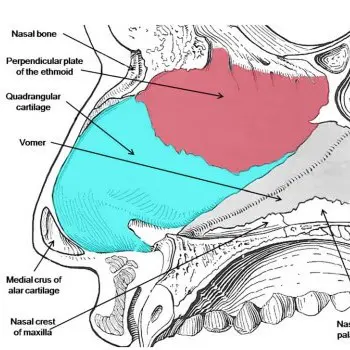August 03, 2022 | Deviated Septum
3 minute read
The Nasal Septum
Before we explore the significance of a deviated septum, it is important to understand the nasal septum better. The nasal septum is a midline structure that partitions the nasal cavity into left and right halves. The nasal septum facilitates proper laminar airflow during nasal breathing and supports the external nose. The septum contains both cartilage and bone and is lined with respiratory mucosa that warms and humidifies the air we breathe. To most people’s surprise, the nasal cavity is much larger than we realize, like a cavern inside the face. Since the nasal septum must reach from the floor to the ceiling of the cavernous nasal cavity and extend from the tip of the nose to where the throat begins, the septum is also much larger than most people would expect.
What causes a deviated septum?
The cause for a septal deviation can be categorized as congenital or acquired. In the developing fetus, the nasal septum forms through the confluence of several structures. This is an imperfect process, and congenital septal deviations may develop due to these components not lining up correctly the way tectonic plates collide and form mountain ranges. Acquired septal deviations usually occur from nasal trauma. Even for those without a definite history of nasal trauma, the accrual of micro-injuries early in life may be enough to result in asymmetric septal development growth that only becomes apparent after growth spurts experienced during puberty.
What are some symptoms associated with a deviated septum?
Nasal obstruction is the most common symptom associated with septal deviation because of the disturbance of normal airflow. This disturbance can also cause nasal drying with crusting, nose bleeds, and decreased sense of smell. Those with a deviated septum are also at higher risk for sinus infections from blockage of the sinus drainage system. Furthermore, because the nasal septum provides direct support for the lower 2/3s of the nose, a deviated septum may also contribute to the appearance of a crooked nose.
Do I need surgery for my deviated septum?
The short answer is it depends. Having a deviated septum alone is not a reason for surgery. In my experience, I can find a certain degree of septal deviation in about 90% of individuals, and most do not need surgery. Therefore, we would only recommend septal surgery for those who are symptomatic. Consider surgery to correct a deviated septum (septoplasty) if your septal deviation is responsible for difficulty breathing through your nose, the appearance of a crooked or twisted nose, or recurrent nose bleeds and sinus infections. A septoplasty is commonly performed together with a rhinoplasty to straighten a crooked nose.
If you have been told that you have a deviated septum and you believe that you may have symptoms related to having a deviated septum, be sure to consult with a board-certified facial plastic surgeon.





